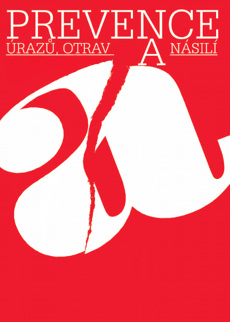NA KOLO JEN S PŘILBOU
ALWAYS WEAR A HELMET WHILE RIDING YOUR BIKE
Martin Sedlák, Jarmila Číhalová
Zdravotní záchranná služba Zlínského kraje, pracoviště Kroměříž;
Zdravotní ústav Zlín, pracoviště Kroměříž
Korespondenční autor: Martin Sedlák (mjsedlak@seznam.cz)
ISSN 1804-7858 (On-line)
Full verze:
Submitted:9. 12. 2008
Accepted: 5. 6. 2009
Published online: 26. 6. 2009
Summary
Traffic injuries are an important cause of morbidity and mortality in children. Bicycle-related injuries are very common. Head injuries caused by bicycle crash are the most frequent causes for hospital admission.
Broad community campaign for bicycle helmets promotion among bicyclists below 15 years old was prepared in Kroměříž. It was later adopted also by other cities. This community campaign was prepared on the basis of PRECEDE model. Predisposing (information in schools), reinforcing (street bonuses) and enabling (helmets discounts) determinants were established.
The frequency of helmet use among children below 10 or 15 years old was only 4% or 3%, respectively, when the helmet use was not compulsory. The frequency of helmet use increased up to 38% when the helmet use was made compulsory. After the community campaign, the frequency of helmet use increased even higher, up to 57%. The incidence of hospital admissions of children below 15 years old for bicycle head injuries decreased significantly in both approached and control groups.
Per capita cost of campaign differed between individual cities, the highest per capita cost was observed in Kroměříž. According these estimates, the intervention pays off moderately well starting the second year of the campaign.
Keywords: helmet use – broad community campaign – PRECEDE behavior model
Souhrn
Mezi závažnými úrazy u dětí vedou dopravní úrazy, z nich pak jsou časté úrazy cyklistické. Nejčastějším důvodem hospitalizace pro úraz na kole je úraz hlavy.
V Kroměříži a pak v dalších městech byla použita široká komunální kampaň na propagaci cyklistických přileb mezi cyklisty do 15 let. Byla vystavěna dle PRECEDE modelu. Byly vytvořeny podmínky navozující (informace na školách), posilující (odměny v ulicích) a umožňující (slevy přileb).
Před zavedením povinného nošení přileb užívala přilbu pouhá 4 %, resp. 3 % dětí do 10, resp. 15 let, po zavedení povinného nošení to bylo 38 %, po kampani pak 57 %. Byl zaznamenán významný pokles incidence hospitalizací do 15 let pro úraz hlavy na kole v oslovené a neoslovené skupině.
Náklady na hlavu byly v jednotlivých městech různé, nejvyšší v Kroměříži. Podle těchto odhadů se intervence mírně vyplácí od druhého roku trvání kampaně.
Klíčová slova: nošení přileb – široká komunální kampaň – ,precede‘ model chování
Literatura
1. Bergman, A. B., Rivara, M. et al.: The Seattle childrens bicycle helmet campaign. Am. J. Dis. Child., 1999, Vol. 144, pp. 727–731.
2. Bruce, B., McGrath, P.: Group interventions for the prevention of injuries in young children: a systematic rewiew. Inj. Prev., 2005. Vol. 11, p. 143–147.
3. Cook, A., Seikh, A.: Trends in serious head injuries among English cyclists and pedestrians. Inj. Prev., 2003. Vol. 9. pp. 266–267.
4. Coté, T. R., Sacks, J. et al.: Bicycle helmet use Among Maryland Children: Effect of Legislation and Education. Pediatrics, 1992. Vol. 89, no. 6, pp. 1216–1220.
5. Dermott, F. T. et al.: The Effectiveness of Bicyclist Helmets: A Study of 1710 Causalties. The Journal of Trauma, 1993. Vol. 34, no. 6, pp. 834–845.
6. Ekmann, R. et al.: Can a Combination of Local, Regional and National Information Substantially Increase Bicykle Helmet Wearing and Reduce Injuries? Accid. Anal. and Prev., 1997. Vol. 29, no. 3, pp. 321–328
7. Finoff, J. T.: Barriers to bicycle helmet use. Pediatrics, 2001. Vol. 108, no. 1.
8. Gielen, A. C., Sleet, D., DIClemente, R.: Injury and Violence prevention. San Francisco: Jossey Bass, 2006.
9. Gilchrist, J. et al.: Police Enforcement as Part of a Comprehensive Bicykle Helmet Program. Pediatrics, 2000. Vol. 106, no. 1, p. 6–9.
10. Grivna, M., Benešová: Cyklistické úrazy u dětí. Čs. Pediat., 1998. Vol. 53, no. 2, pp. 108–111.
11. Karkhaneh, M., Kalenga, J. C., Hagel, B. E., Rowe, B., H.: Effectiveness of bicykle helmet legislation to increase helmet use: a systematic review. Inj. Prev., 2006. Vol. 12, no. 2, pp. 76–82.
12. Koutek, J., Kocourková, J.: Reakce na závažný úraz v adolescenci. Čs. Pediat., 1999. Vol. 54, no. 10, pp. 600–601.
13. Logan, P., Leadbetter, P. et al.: Evaluation of a Bicykle Helmet Giveaway Program – Texas. Pediatrics, 1998. Vol. 101, no. 4, pp. 578–582.
14. Loubeau, P. R.: Exploration of the barriers to bicykle helmet use among 12 and 13 yer old children. Accident Analysis and Prevention, 2000. Vol. 32, pp. 111–115.
15. Parkin, P. C., Hu, X. et al: Evaluation of a Subsidy Program to Increase Bicycle Helmet Use by Children in Low-Income Families. Pediatrics, Vol. 96, no. 2. pp 283–287.
16. Pelech, L., Roth, R. et al.: Úrazy a děti. Čas. Lék. čes., 1998. Vol. 137, no. 15, pp. 460–463.
17. Rivara, F. P. et al : The Seattle Children’s Bicycle Helmet Acampaign: Changes in Helmet Use and Head Injury Admissions. Pediatrics, 1994. Vol. 93, no. 4, pp. 567–569.
18. Spinks, A., Turner, C., McCllure, R., Acton, C.: Community-based programmes to promote use of bicykle helmets in children aged 0–14 years: a systematic rewiew. Int. Journal of Injury Control, 2005. Vol. 12, no. 3, pp. 131–142.
19. Thompson, N. J. et al.: Increasing the use of bicykle helmets: lessons from behavioral science Pacient Education and Counseling, 2002. Vol. 46, pp. 191–197.
20. Vulcan, A. P., Cameron, M. et al.: Mandatory Bicycle Helmet Use: Expirience in Victoria, Australia. World Journal of Surgery, 1992. Vol. 16, pp. 389–397.
21. Wesson, D. et al.: Trends in Bicycling-Rrelated Head injuries in Children After Implementation of a community Based Bike Helmet Campaign. Journal of Pediatric Surgery, 2000. Vol. 35, no. 5, pp 688–689
22. Statistika dopravních nehod: [www.mvcr.cz/…/12_2005.pdf] 11. 12. 2007
